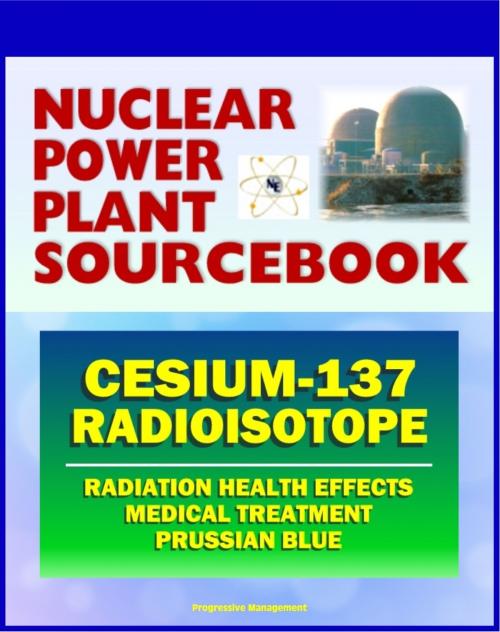2011 Nuclear Power Plant Sourcebook: Cesium-137 Radioisotope, Radiation Health Effects and Toxicological Profile, Medical Treatment with Prussian Blue, Fukushima Accident Radioactive Release
Nonfiction, Science & Nature, Science, Physics, General Physics, Social & Cultural Studies, Political Science| Author: | Progressive Management | ISBN: | 9781458173270 |
| Publisher: | Progressive Management | Publication: | March 15, 2011 |
| Imprint: | Smashwords Edition | Language: | English |
| Author: | Progressive Management |
| ISBN: | 9781458173270 |
| Publisher: | Progressive Management |
| Publication: | March 15, 2011 |
| Imprint: | Smashwords Edition |
| Language: | English |
Cesium-137, a radioisotope with significant health implications that can be generated by nuclear power plant accidents and meltdowns, is fully covered in this authoritative collection of official documents with details about the health and medical impacts of this dangerous fission product. Traces of cesium-137 were detected coming from the damaged reactors at the Japanese Fukushima Power Station in March 2011. A complete toxicological profile of cesium-137 from the Agency for Toxic Substances and Disease Registry (ATSDR) is included. There is also full coverage of a drug, prussian blue, that can be used to treat people who have been internally contaminated with Cs-137. Radioactive cesium-137 is produced when uranium and plutonium absorb neutrons and undergo fission. Examples of the uses of this process are nuclear reactors and nuclear weapons. The splitting of uranium and plutonium in fission creates numerous fission products. Cesium-137 is one of the more well-known fission products. Cesium-137 in the environment came from a variety of sources. The largest single source was fallout from atmospheric nuclear weapons tests in the 1950s and 1960s, which dispersed and deposited cesium-137 world-wide. However much of the cesium-137 from testing has now decayed. Nuclear reactor waste and accidental releases such as the Chernobyl accident in the Ukraine release some cesium-137 to the environment. Spent nuclear fuel reprocessing plant wastes may introduce small amounts to the environment. However, the U.S. does not currently reprocess spent nuclear fuel.
Since the 1960s, Prussian blue has been used to treat people who have been internally contaminated with radioactive cesium (mainly Cs-137) and nonradioactive thallium (once an ingredient in rat poisons). Doctors can prescribe Prussian blue at any point after they have determined that a person who is internally contaminated would benefit from treatment. Prussian blue will help speed up the removal of cesium and thallium from the body. Prussian blue traps radioactive cesium and thallium (mainly Tl-201) in the intestines and keeps them from being re-absorbed by the body. The radioactive materials then move through the intestines and are excreted (passed) in bowel movements. Prussian blue reduces the biological half-life1 of cesium from about 110 days to about 30 days. Prussian blue reduces the biological half-life of thallium from about 8 days to about 3 days. Because Prussian blue reduces the time that radioactive cesium and thallium stay in the body, it helps limit the amount of time the body is exposed to radiation.
This is a privately authored news service and educational publication of Progressive Management.
Cesium-137, a radioisotope with significant health implications that can be generated by nuclear power plant accidents and meltdowns, is fully covered in this authoritative collection of official documents with details about the health and medical impacts of this dangerous fission product. Traces of cesium-137 were detected coming from the damaged reactors at the Japanese Fukushima Power Station in March 2011. A complete toxicological profile of cesium-137 from the Agency for Toxic Substances and Disease Registry (ATSDR) is included. There is also full coverage of a drug, prussian blue, that can be used to treat people who have been internally contaminated with Cs-137. Radioactive cesium-137 is produced when uranium and plutonium absorb neutrons and undergo fission. Examples of the uses of this process are nuclear reactors and nuclear weapons. The splitting of uranium and plutonium in fission creates numerous fission products. Cesium-137 is one of the more well-known fission products. Cesium-137 in the environment came from a variety of sources. The largest single source was fallout from atmospheric nuclear weapons tests in the 1950s and 1960s, which dispersed and deposited cesium-137 world-wide. However much of the cesium-137 from testing has now decayed. Nuclear reactor waste and accidental releases such as the Chernobyl accident in the Ukraine release some cesium-137 to the environment. Spent nuclear fuel reprocessing plant wastes may introduce small amounts to the environment. However, the U.S. does not currently reprocess spent nuclear fuel.
Since the 1960s, Prussian blue has been used to treat people who have been internally contaminated with radioactive cesium (mainly Cs-137) and nonradioactive thallium (once an ingredient in rat poisons). Doctors can prescribe Prussian blue at any point after they have determined that a person who is internally contaminated would benefit from treatment. Prussian blue will help speed up the removal of cesium and thallium from the body. Prussian blue traps radioactive cesium and thallium (mainly Tl-201) in the intestines and keeps them from being re-absorbed by the body. The radioactive materials then move through the intestines and are excreted (passed) in bowel movements. Prussian blue reduces the biological half-life1 of cesium from about 110 days to about 30 days. Prussian blue reduces the biological half-life of thallium from about 8 days to about 3 days. Because Prussian blue reduces the time that radioactive cesium and thallium stay in the body, it helps limit the amount of time the body is exposed to radiation.
This is a privately authored news service and educational publication of Progressive Management.















